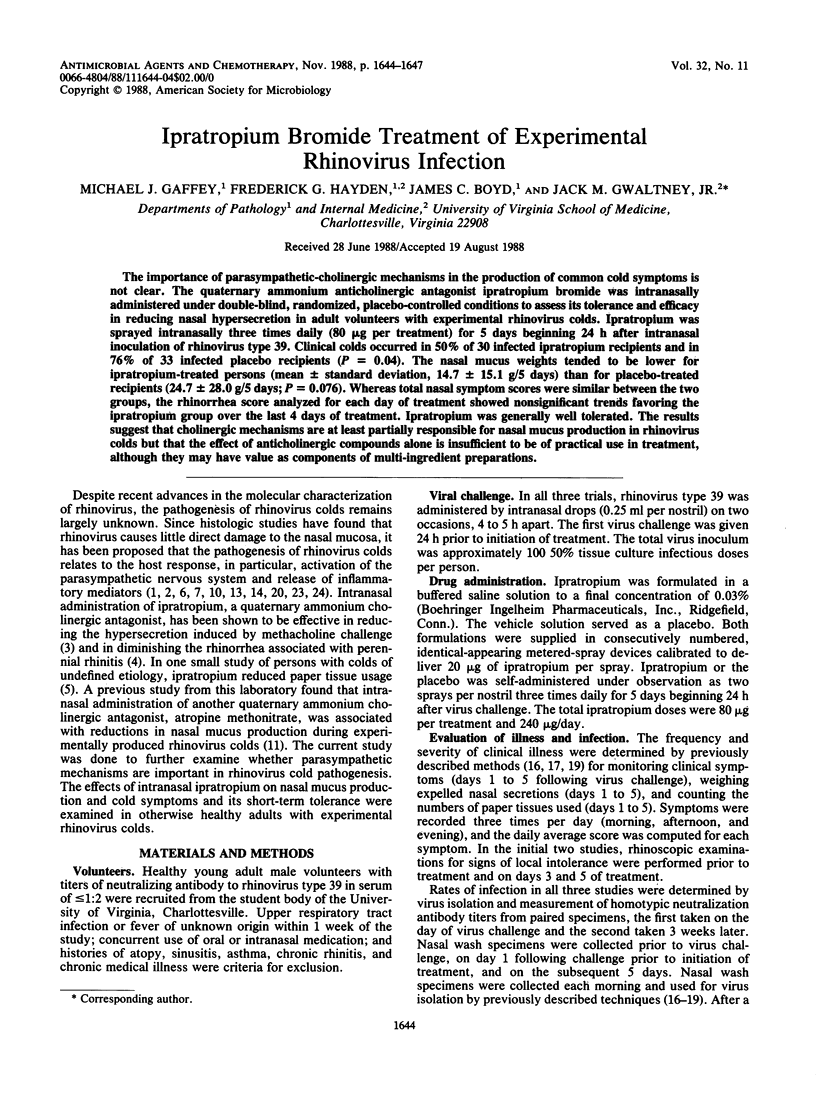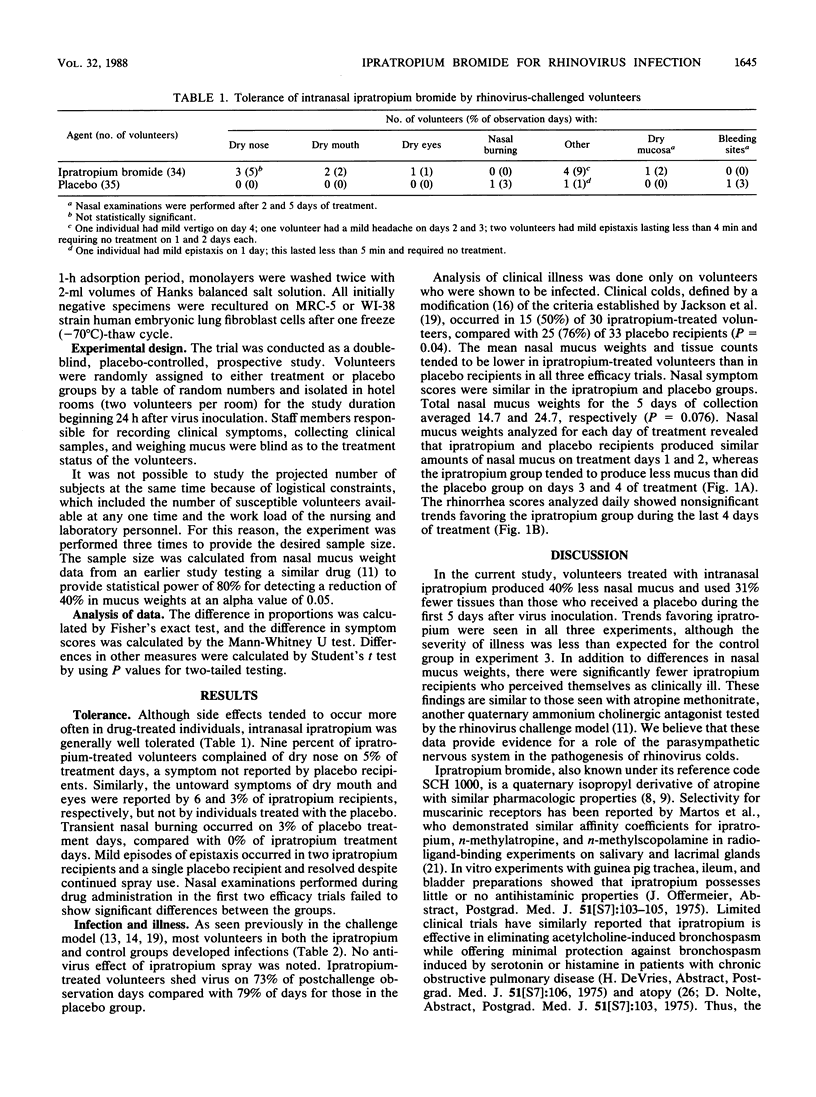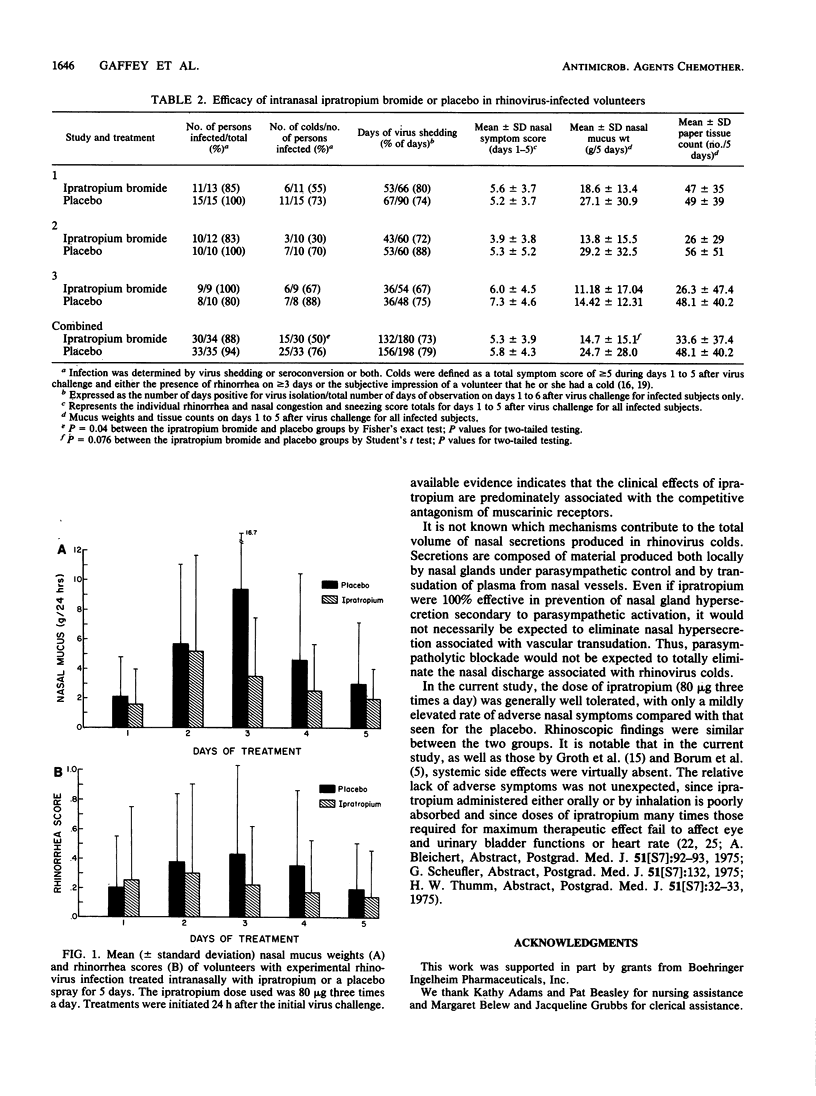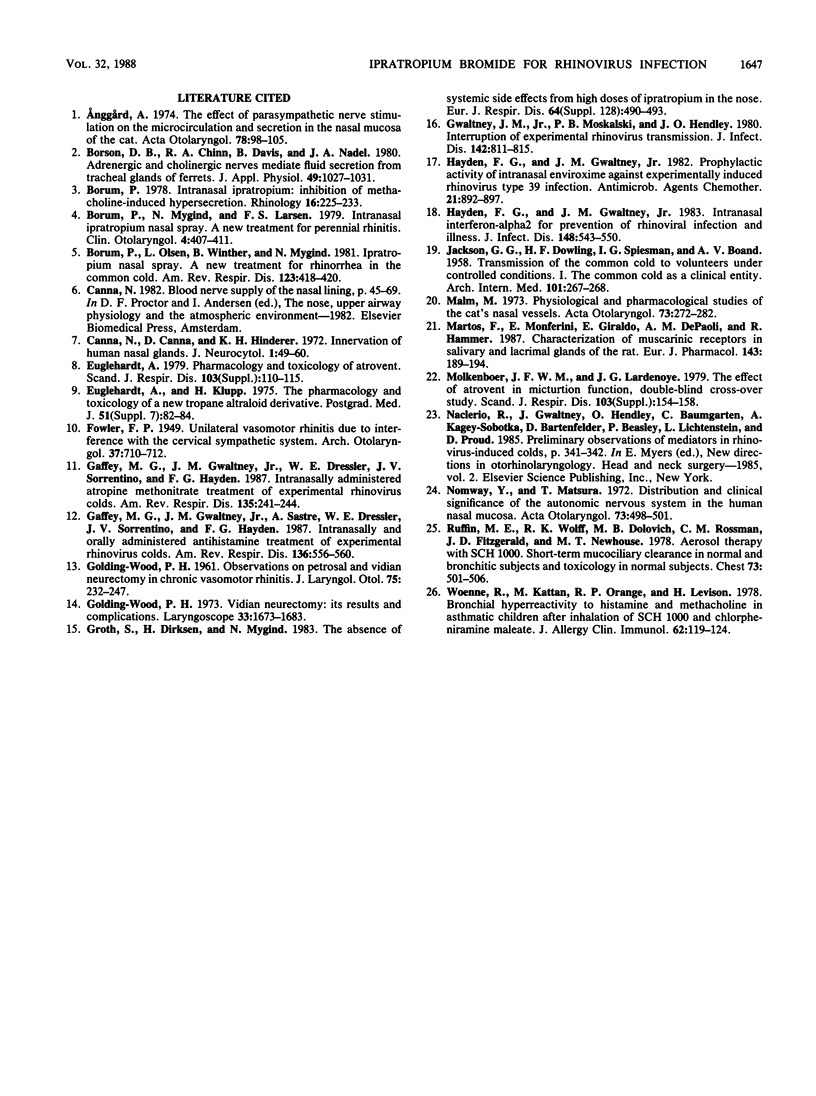Abstract
The importance of parasympathetic-cholinergic mechanisms in the production of common cold symptoms is not clear. The quaternary ammonium anticholinergic antagonist ipratropium bromide was intranasally administered under double-blind, randomized, placebo-controlled conditions to assess its tolerance and efficacy in reducing nasal hypersecretion in adult volunteers with experimental rhinovirus colds. Ipratropium was sprayed intranasally three times daily (80 micrograms per treatment) for 5 days beginning 24 h after intranasal inoculation of rhinovirus type 39. Clinical colds occurred in 50% of 30 infected ipratropium recipients and in 76% of 33 infected placebo recipients (P = 0.04). The nasal mucus weights tended to be lower for ipratropium-treated persons (mean +/- standard deviation, 14.7 +/- 15.1 g/5 days) than for placebo-treated recipients (24.7 +/- 28.0 g/5 days; P = 0.076). Whereas total nasal symptom scores were similar between the two groups, the rhinorrhea score analyzed for each day of treatment showed nonsignificant trends favoring the ipratropium group over the last 4 days of treatment. Ipratropium was generally well tolerated. The results suggest that cholinergic mechanisms are at least partially responsible for nasal mucus production in rhinovirus colds but that the effect of anticholinergic compounds alone is insufficient to be of practical use in treatment, although they may have value as components of multi-ingredient preparations.
Full text
PDF



Selected References
These references are in PubMed. This may not be the complete list of references from this article.
- Anggård A. The effects of parasympathetic nerve stimulation on the microcirculation and secretion in the nasal mucosa of the cat. Acta Otolaryngol. 1974 Jul-Aug;78(1-2):98–105. [PubMed] [Google Scholar]
- Borson D. B., Chin R. A., Davis B., Nadel J. A. Adrenergic and cholinergic nerves mediate fluid secretion from tracheal glands of ferrets. J Appl Physiol Respir Environ Exerc Physiol. 1980 Dec;49(6):1027–1031. doi: 10.1152/jappl.1980.49.6.1027. [DOI] [PubMed] [Google Scholar]
- Borum P. Intranasal ipratropium: inhibition of methacholine induced hypersecretion. Rhinology. 1978 Dec;16(4):225–233. [PubMed] [Google Scholar]
- Borum P., Mygind N., Schultz Larsen F. Intranasal ipratropium: a new treatment for perennial rhinitis. Clin Otolaryngol Allied Sci. 1979 Dec;4(6):407–411. doi: 10.1111/j.1365-2273.1979.tb01773.x. [DOI] [PubMed] [Google Scholar]
- Borum P., Olsen L., Winther B., Mygind N. Ipratropium nasal spray: a new treatment for rhinorrhea in the common cold. Am Rev Respir Dis. 1981 Apr;123(4 Pt 1):418–420. doi: 10.1164/arrd.1981.123.4.418. [DOI] [PubMed] [Google Scholar]
- Cauna N., Cauna D., Hinderer K. H. Innervation of human nasal glands. J Neurocytol. 1972 Jul;1(1):49–60. doi: 10.1007/BF01098645. [DOI] [PubMed] [Google Scholar]
- Engelhardt A., Klupp H. The pharmacology and toxicology of a new tropane alkaloid derivative. Postgrad Med J. 1975;51(7 Suppl):82–85. [PMC free article] [PubMed] [Google Scholar]
- GOLDING-WOOD P. H. Observations on petrosal and vidian neurectomy in chronic vasomotor rhinitis. J Laryngol Otol. 1961 Mar;75:232–247. doi: 10.1017/s0022215100057716. [DOI] [PubMed] [Google Scholar]
- Gaffey M. J., Gwaltney J. M., Jr, Dressler W. E., Sorrentino J. V., Hayden F. G. Intranasally administered atropine methonitrate treatment of experimental rhinovirus colds. Am Rev Respir Dis. 1987 Jan;135(1):241–244. doi: 10.1164/arrd.1987.135.1.241. [DOI] [PubMed] [Google Scholar]
- Gaffey M. J., Gwaltney J. M., Jr, Sastre A., Dressler W. E., Sorrentino J. V., Hayden F. G. Intranasally and orally administered antihistamine treatment of experimental rhinovirus colds. Am Rev Respir Dis. 1987 Sep;136(3):556–560. doi: 10.1164/ajrccm/136.3.556. [DOI] [PubMed] [Google Scholar]
- Golding-Wood P. H. Vidian neurectomy: its results and complications. Laryngoscope. 1973 Oct;83(10):1673–1683. doi: 10.1288/00005537-197310000-00008. [DOI] [PubMed] [Google Scholar]
- Groth S., Dirksen H., Mygind N. The absence of systemic side-effects from high doses of ipratropium in the nose. Eur J Respir Dis Suppl. 1983;128(Pt 2):490–493. [PubMed] [Google Scholar]
- Gwaltney J. M., Jr, Moskalski P. B., Hendley J. O. Interruption of experimental rhinovirus transmission. J Infect Dis. 1980 Dec;142(6):811–815. doi: 10.1093/infdis/142.6.811. [DOI] [PubMed] [Google Scholar]
- Hayden F. G., Gwaltney J. M., Jr Intranasal interferon alpha 2 for prevention of rhinovirus infection and illness. J Infect Dis. 1983 Sep;148(3):543–550. doi: 10.1093/infdis/148.3.543. [DOI] [PubMed] [Google Scholar]
- Hayden F. G., Gwaltney J. M., Jr Prophylactic activity of intranasal enviroxime against experimentally induced rhinovirus type 39 infection. Antimicrob Agents Chemother. 1982 Jun;21(6):892–897. doi: 10.1128/aac.21.6.892. [DOI] [PMC free article] [PubMed] [Google Scholar]
- JACKSON G. G., DOWLING H. F., SPIESMAN I. G., BOAND A. V. Transmission of the common cold to volunteers under controlled conditions. I. The common cold as a clinical entity. AMA Arch Intern Med. 1958 Feb;101(2):267–278. doi: 10.1001/archinte.1958.00260140099015. [DOI] [PubMed] [Google Scholar]
- Martos F., Monferini E., Giraldo E., De Paoli A. M., Hammer R. Characterization of muscarinic receptors in salivary and lacrimal glands of the rat. Eur J Pharmacol. 1987 Nov 10;143(2):189–194. doi: 10.1016/0014-2999(87)90532-2. [DOI] [PubMed] [Google Scholar]
- Molkenboer J. F., Lardenoye J. G. The effect of Atrovent in micturition function, double blind cross-over study. Scand J Respir Dis Suppl. 1979;103:154–158. [PubMed] [Google Scholar]
- Ruffin R. E., Wolff R. K., Dolovich M. B., Rossman C. M., Fitzgerald J. D., Newhouse M. T. Aerosol therapy with Sch 1000. Short-term mucociliary clearance in normal and bronchitic subjects and toxicology in normal subjects. Chest. 1978 Apr;73(4):501–506. doi: 10.1378/chest.73.4.501. [DOI] [PubMed] [Google Scholar]
- Woenne R., Kattan M., Orange R. P., Levison H. Bronchial hyperreactivity to histamine and methacholine in asthmatic children after inhalation of SCH 1000 and chlorpheniramine maleate. J Allergy Clin Immunol. 1978 Aug;62(2):119–124. doi: 10.1016/0091-6749(78)90089-1. [DOI] [PubMed] [Google Scholar]


